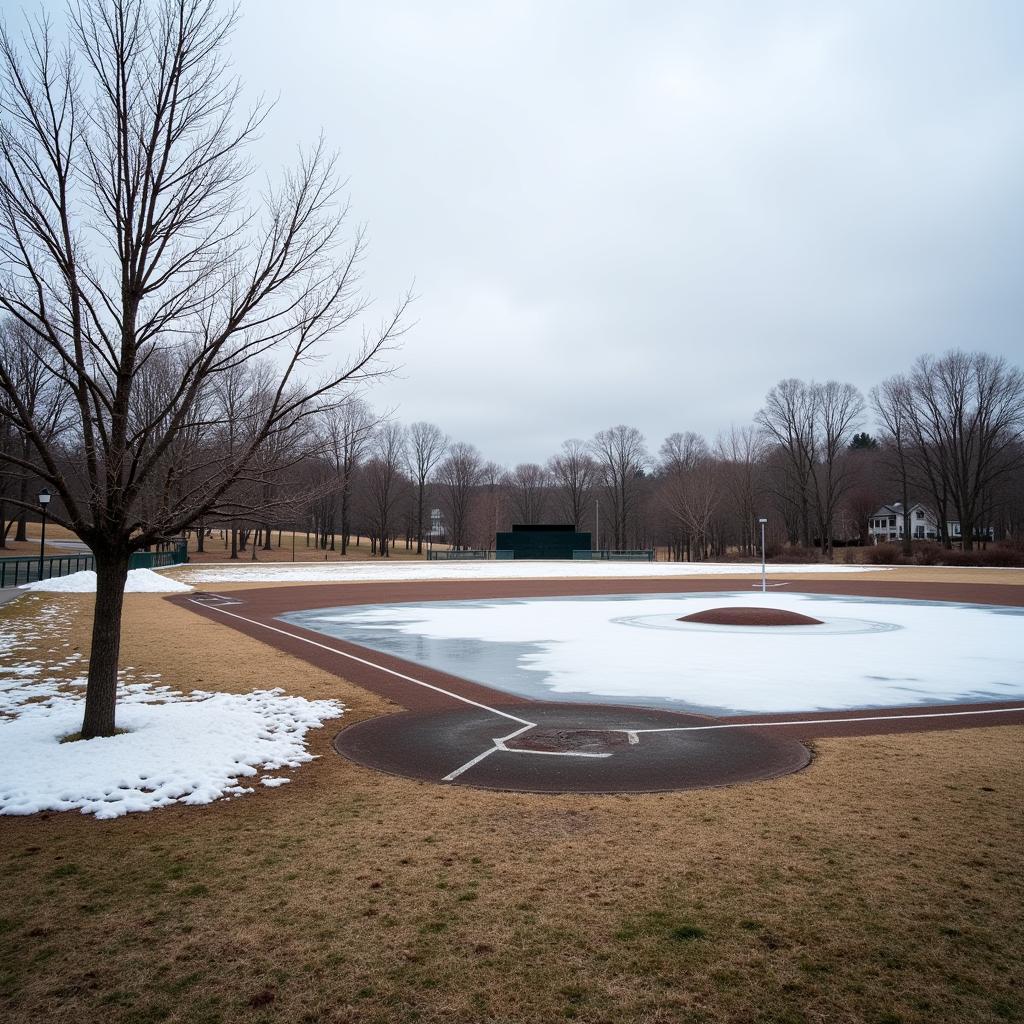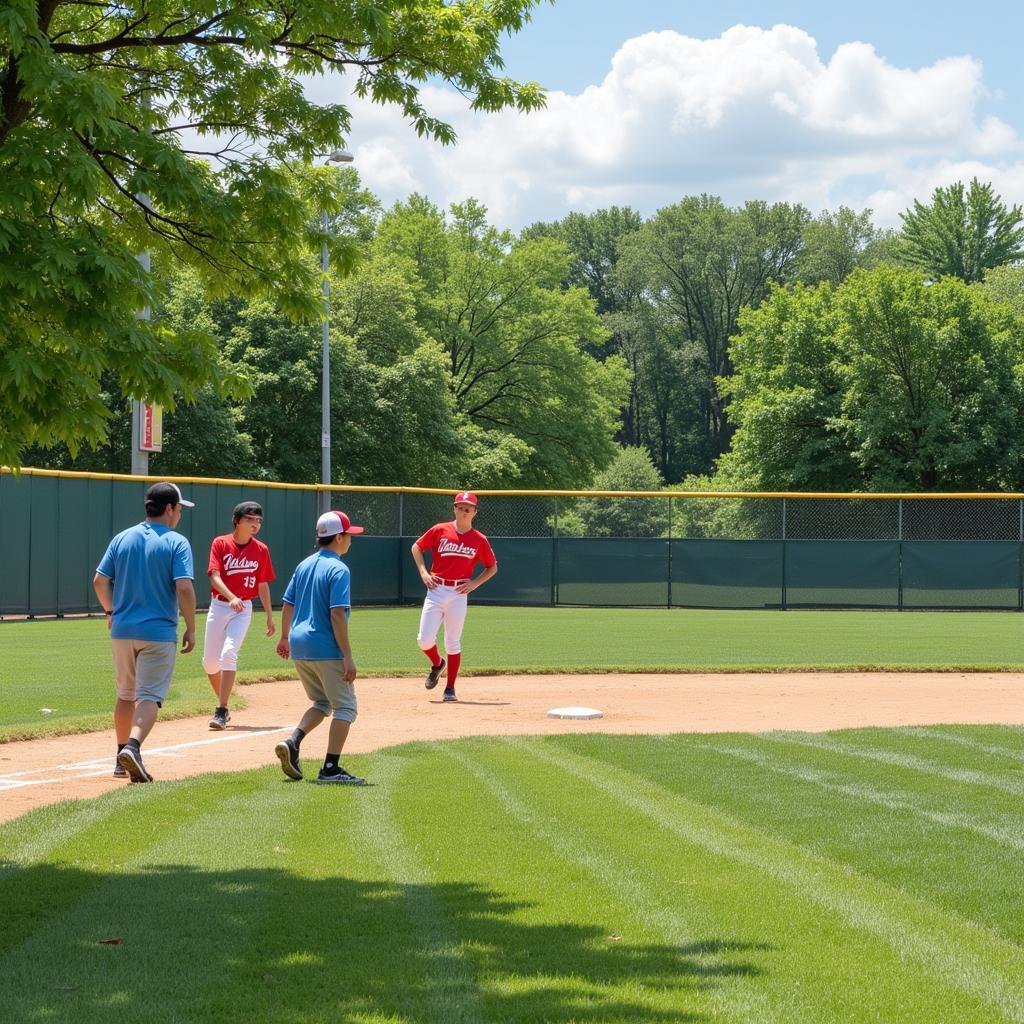Allentown Spring Melt: Navigating the Thaw and Pitch Prep
October 16, 2024Allentown Spring Melt signals the end of winter’s frosty grip and the much-anticipated arrival of baseball season. As the snow and ice slowly recede, baseball fields across Allentown come alive with the familiar sounds of gloves popping and bats cracking. But before you can enjoy those sunny days on the diamond, there’s a crucial step: preparing your playing field for the season ahead.
From Frozen Tundra to Field of Dreams: Understanding Allentown Spring Melt
Allentown’s spring melt is a unique phenomenon. The combination of temperature fluctuations, precipitation, and soil type can create challenges for groundskeepers looking to get their fields game-ready. Understanding these factors is key to a successful spring thaw and a smooth transition into the baseball season.
The Impact of Temperature Swings
Allentown’s spring shoulder season is known for its unpredictable weather. Warm days followed by freezing nights can wreak havoc on your baseball diamond. As temperatures rise above freezing, the top layer of snow and ice melts, creating a muddy surface. When temperatures plummet overnight, this surface freezes, forming a layer of ice that can damage the grass and create uneven playing conditions.
Precipitation and the Importance of Drainage
Spring in Allentown often brings rain, sleet, and even the occasional late-season snowfall. This excess moisture can exacerbate drainage issues, turning your outfield into a soggy mess. Proper drainage is crucial during the spring melt to prevent waterlogging, soil erosion, and damage to the playing surface.
Soil Type and its Role in Spring Thaw
The type of soil beneath your baseball field plays a significant role in how quickly it drains and recovers from winter’s chill. Heavy clay soils tend to retain water, making them susceptible to waterlogging. Sandy soils, on the other hand, drain quickly but may require additional amendments to improve water retention and nutrient levels.
 Allentown Baseball Field During Spring Thaw
Allentown Baseball Field During Spring Thaw
Prepping for Play: Essential Steps for Post-Melt Field Maintenance
Once the majority of the snow and ice have melted, it’s time to assess your baseball field and begin the essential steps of post-melt maintenance.
1. Assessing the Damage
The first step is to carefully inspect your field for any signs of winter damage. This includes checking for:
- Ice damage: Look for areas of turf that have been lifted or damaged by ice formation.
- Snow mold: Watch for patches of white or pink fungus, a common issue after snow cover.
- Drainage problems: Identify areas where water is pooling or draining slowly.
- Erosion: Inspect for any signs of soil erosion, particularly on slopes or areas with heavy water runoff.
2. Addressing Drainage Issues
If you identify drainage problems, address them promptly. This may involve:
- Aerating the soil: Aeration helps to improve drainage by creating small holes that allow water and air to penetrate the soil more easily.
- Adding drainage channels: Installing drainage channels can help to redirect water away from problem areas.
- Amending the soil: Incorporating organic matter, such as compost, can improve drainage in heavy clay soils.
 Groundskeeper Assessing Drainage on Baseball Field
Groundskeeper Assessing Drainage on Baseball Field
3. Repairing and Overseeding
Once drainage issues are addressed, repair any damaged areas of turf. This may involve:
- Raking and removing debris: Clear the field of any remaining leaves, branches, or other debris that may have accumulated over the winter.
- Reseeding bare patches: Overseed any bare patches with a quality grass seed mix.
- Topdressing: Apply a thin layer of topsoil or compost to help level out uneven areas and promote healthy grass growth.
4. Gradual Return to Play
It’s crucial to allow your field adequate time to recover before resuming full activity. Gradually increase usage over several weeks, starting with light practices and progressing to full games.
Expert Advice: Tips from the Field
“Patience is key when it comes to spring melt and field preparation,” says John Smith, Head Groundskeeper for the Allentown IronPigs. “Don’t rush the process. Allow the field to dry out naturally and avoid heavy use until the turf is fully recovered. Proper preparation during the spring thaw sets the stage for a successful and enjoyable baseball season.”
 Allentown Youth Baseball Team Practicing
Allentown Youth Baseball Team Practicing
Conclusion
Allentown spring melt marks a time of renewal and excitement for baseball enthusiasts. By understanding the unique challenges of the spring thaw and following these essential field maintenance tips, you can ensure that your baseball diamond is ready for action when the first pitch is thrown.
FAQ
Q: How long does it take for a baseball field to recover from the spring melt?
A: The recovery time varies depending on several factors, including the severity of the winter, the soil type, and the amount of precipitation. In general, it can take several weeks for a field to fully recover.
Q: When can I start mowing my baseball field after the spring melt?
A: Wait until the grass is dry and at least 3 inches tall before mowing. Avoid mowing too short, as this can stress the turf and make it more susceptible to disease.
Q: What can I do to prevent snow mold from forming on my baseball field?
A: Rake leaves and debris off the field in the fall to promote air circulation and discourage snow mold growth. Fungicide applications may be necessary in areas with a history of snow mold problems.
Need Help? We’re Here to Assist!
For personalized advice on Allentown spring melt and field maintenance, contact us at:
Phone: 0963418788
Email: [email protected]
Address: 2M4H+PMH, Phường Nghĩa Thành, Gia Nghĩa, Đắk Nông, Việt Nam
Our dedicated team is available 24/7 to answer your questions and provide expert guidance.